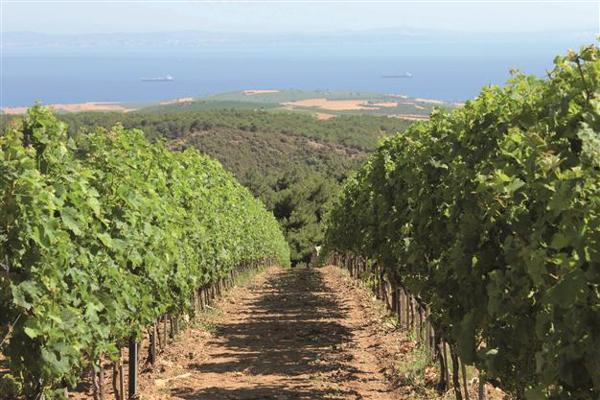Traces of Thracian tastes
AYLİN ÖNEY TAN - aylinoneytan@yahoo.com


Almost instantly we jumped into the topic of indigenous sheep varieties and the much praised lamb cutlets of the Thrace region. He abruptly made a sharp comment, saying sternly: My dear Aylin Hanım, if we love these animals, we have to eat them!
It was stark, but I got the point at once. For the sustainability of regional foods, we need to create a market for them. We need to recognize them, know their qualities, and be willing to pay for their value and keep demanding them. If we opt for the cheaper meat cuts and products of farm-fed industrialized husbandry, and do not pay for the high quality rare breeds, we will soon lose them forever, sooner then we think. Prof. İhsan Soysal knew that so well and dedicated himself to protecting the indigenous farm animals of Anatolia, not only documenting and researching about them, but also initiating many projects to sustain their existence. The next day, I was introducing him to just the right people in Istanbul at a conference on geographical appellation. Eventually he became a member of my Slow Food group and represented Turkey in Italy as a delegate of Terra Madre. He spent his days in Torino visiting every butcher possible, spotting local breeds. He is one of the few who is aware of the virtues of the Thrace region and does all what is needed to protect local tastes, some in danger of losing their particular character.
The Thrace area consists of the European part of Turkey, a relatively lesser-known region, definitely not recognized as a top tourism destination, despite its beautiful landscape and wonderful tastes. Its agricultural values are unfortunately not accredited enough, though famous for its meatballs, lamb, cheeses and wines; the sustainability of quality and authenticity seems to be a problem. That is what has previously happened with the famed wines of the Thrace region. During the Byzantine period, the trade route connecting Constantinople and Venice was almost entirely dependent on the much-praised Thracian wines. Historian Ilias Anagnostakis, who has done much research on Byzantine tastes and flavors, gives detailed maps of viticulture and important export ports in the Thrace area. Somehow in the course of history, the region lost its fame for fine wines, but became better known for the strong spirit, Tekirdağ rakı or cheaper wines, often nicknamed “dog-killers.” Luckily, in the past few decades, there has been a complete reverse of action, thanks to a few brave hearts like Prof. Soysal. The new wave wine producers of Thrace were united last year to have a joint project to promote the Thrace Vineyard Routes. There is something odd about Thrace, everybody in the wine business here seems to be a bit crazy. They have all been in various parts of the world, most are accomplished engineers, some were international businessmen, now returned to their homeland and started to make wine. They are all passionate about what they’re doing. Reviving the viticulture has not been easy, wine making here is often a painful process, even more so when it comes to selling your wine. Marketing is not easy, competing with bigger producers is often just impossible. This project has a gain for both the tourism of the Thrace region and for the smaller wineries. Apparently the boutique wineries and vineyards will be the strong attraction for many who live in Istanbul and long for an escape outside the city for an outdoor weekend. Thrace Development Agency, along with the Thrace Tourism Association (TTID), is aware of this fact and is supporting the project wholeheartedly. Wines may be the driving force behind this project, which aims to promote tourism, but it has to embrace the region’s gastronomic values as well. I await their future plans to also promote the praised lambs and cheeses that will completely complement the lovely wines.
Here you can download all the information about the wineries and the project:
http://www.ttid.org.tr/upload/files/eng.pdf
Bite of the week
Fork of the Week: I strongly advise the slow-braised Thracian lamb with
prunes in my new favorite restaurant La Fumée. The team of Can Ünsal and
Pınar Taşdemir creates wonders. Chef Pınar will become the queen of the
Turkish restaurant scene in the near future; she is one that
understands the value of true ingredients. The plus side is the venue is
relaxed, conveniently located behind the Makro market in Kuruçeşme,
with a lovely view of Bosporus, but who cares for the view when you have
such delights on your plate. Muallim Naci Caddesi No.64/D; 0212 257 02
93. http://fumeerestaurant.com/
Cork of the Week: Excitement is in the air! Beaujolais Nouveau will be out on the third Thursday of November. There is only one winery in Turkey that has kept this tradition since 1988; Kavaklıdere winery produces Beaujolais Nouveau under the name Primeur, and launches its new babies on the evening of Nov. 20. The white Primeur is a blend Sauvignon Blanc and Narince, often delightfully fresh with a lively acidity, and the red is a single grape Öküzgözü, hopefully very plummy and fruity. Well, we’ll see in a few days!

